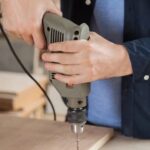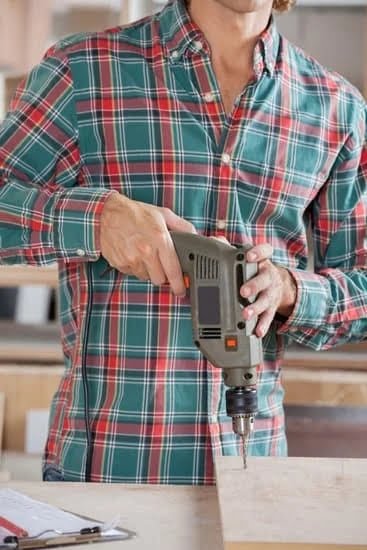Woodworking is a craft that requires precision and accuracy. Whether you’re building furniture, constructing cabinets, or crafting intricate designs, understanding and calculating angles is crucial. In this article, we will explore the importance of calculating angles in woodworking and provide you with the knowledge and tools to master this skill.
Accurate angle measurements are essential in ensuring that joints fit together perfectly, edges align seamlessly, and overall stability of your woodworking projects. Even the slightest miscalculation can lead to ill-fitting pieces, compromised structural integrity, and a finished product that falls short of your expectations. Therefore, having a deep understanding of different types of angles and how to measure them is indispensable for any woodworker.
In the realm of woodworking, there are various types of angles: acute angles, obtuse angles, right angles, compound angles, and more. Each angle serves a unique purpose in different projects. By mastering the art of angle calculation, you gain the ability to execute complex designs with precision and finesse.
In the following sections of this article, we will delve into basic angle measurement techniques and introduce you to the essential tools needed for accurate calculations. From traditional measuring devices like protractors and bevel gauges to modern digital angle finders, we will cover it all. Additionally, we will provide step-by-step guides on calculating both standard and advanced angles in woodworking contexts.
By the end of this article, you will not only have the expertise to calculate various types of angles but also be equipped with troubleshooting tips for common mistakes made during angle calculations. So get ready to enhance your woodworking skills as we journey through the art of calculating angles for precise craftsmanship.
Understanding Basic Angle Measurement
In woodworking, understanding basic angle measurement is essential for achieving precise and accurate cuts. Whether you’re working on a simple DIY project or crafting intricate furniture pieces, having a good grasp of angles and how to measure them is crucial. This section will provide an overview of angle measurement, including the definition of angles and the various units used in woodworking.
Definition of Angles
An angle is formed when two lines intersect at a point called the vertex. It can be measured in degrees (°) or radians (rad). In woodworking, degrees are most commonly used for angle measurement. A full circle is divided into 360 degrees, with each degree representing 1/360th of a circle.
Angles are classified based on their measurements:
- Acute angles: Angles measuring less than 90 degrees.
- Right angles: Angles that exactly measure 90 degrees.
- Obtuse angles: Angles measuring greater than 90 degrees but less than 180 degrees.
- Straight angles: Angles that exactly measure 180 degrees.
- Reflex angles: Angles measuring greater than 180 degrees but less than 360 degrees.
Measurement Units used in Woodworking
In addition to degrees, there are other units used for angle measurement in woodworking:
- Minutes (‘): Each degree is divided into 60 minutes. For example, an angle measuring 45° and 30′ means it is equivalent to 45 degrees and an additional 30 minutes.
- Seconds (“): Each minute is further divided into 60 seconds. For precise measurements, seconds are used after minutes.
Understanding these basic definitions and measurement units lays the foundation for accurate angle calculation in woodworking projects. Now let’s move on to the tools and materials needed to accurately measure and calculate angles in woodworking.
Tools and Materials Needed for Angle Calculation
To accurately calculate angles in woodworking, it is essential to have the right tools and materials at your disposal. Without the proper measuring devices and equipment, achieving precise angle measurements can be challenging. In this section, we will discuss the tools and materials needed for angle calculation in woodworking.
Some of the essential tools for accurately measuring angles include protractors, bevel gauges, and combination squares. Protractors are commonly used to measure angles ranging from 0 to 180 degrees. They consist of a flat base with a half-circle or semicircular component that incorporates a degree scale.
Bevel gauges are handy tools that allow you to determine existing angles or transfer them from one workpiece to another. Combination squares are versatile tools that include both a ruler and a protractor, making them useful for various tasks in addition to angle measurement.
In addition to these specific measuring devices, other materials like pencils or marking knives are necessary for marking accurate measurements on wood surfaces. These markers help ensure precision during the calculation process and aid in creating clear lines for cutting or shaping wood accurately.
By having these tools readily available in your woodworking arsenal, you can confidently embark on calculating accurate angles for your projects. With practice and familiarity with these measuring instruments, you will be able to achieve greater accuracy in all your woodworking endeavors.
Calculating Standard Angles
When it comes to woodworking, accurately calculating angles is essential for successful and visually pleasing projects. In this section, we will provide you with a step-by-step guide on how to calculate common angles in woodworking. These calculations will help you achieve precise cuts for various joints and corners.
One commonly used angle in woodworking is the 45-degree miter cut. This joint is often used to create clean and seamless corners for frames, boxes, and other projects. To calculate a 45-degree angle, follow these steps:
- Start by using a combination square or protractor to measure and mark a straight line on your wood.
- From one end of the line, measure and mark the length that you want the miter cut to be.
- From that mark, use your combination square or protractor to draw a 45-degree angle line that intersects with the first line you drew.
- Double-check your measurements and use a saw to carefully cut along the marked line.
- Test the fit of the two pieces by joining them together at a right angle. Sand or trim as needed for a perfect fit.
Another standard angle frequently used in woodworking is the 90-degree corner joint. This joint is widely utilized in constructing cabinets, tables, and boxes where accuracy is crucial for stability and aesthetic appeal. To calculate a 90-degree angle, follow these steps:
- Similar to the previous example, start by marking a straight line on your wood using a combination square or protractor.
- Measure and mark equal lengths from each end of the line you drew (the length of these marks will depend on your project).
- Use your combination square or protractor to draw two perpendicular lines connecting each marked point with their corresponding end of the original line.
- Double-check your measurements and use a saw to make precise cuts along each of these lines.
- When joining the pieces together, ensure that the corner is square by using a square or checking for equal diagonal measurements.
By understanding and mastering these standard angle calculations, you’ll be able to tackle various woodworking projects with confidence and accuracy. Practice these techniques on scrap wood before attempting them on your actual project to enhance your skills and avoid potential mistakes. With precise calculations, your woodworking projects will appear more professional and polished, showcasing your expertise in the craft.
Advanced Angle Calculation Techniques
Compound Angles
When it comes to more intricate woodworking projects, you may encounter situations where you need to cut compound angles. A compound angle involves two different angles occurring simultaneously on a single piece of wood. These angles can be challenging to calculate, but with the right techniques and tools, you can achieve precise cuts.
To calculate compound angles, start by determining the primary angle. This is the angle that occurs in the vertical plane when looking at the end grain of your piece of wood. Measure and mark this angle using a protractor or a digital angle finder.
Next, identify the secondary angle. This is the angle that occurs in the horizontal plane when looking at the face of your piece of wood. To find this angle, use a bevel gauge or combination square to measure and mark it.
Once you have both angles identified and marked on your wood, carefully align your saw blade according to these measurements. Take your time to ensure accuracy, as even slight deviations can result in misaligned joints or uneven cuts.
Obtuse Angles
Woodworking projects sometimes require cutting obtuse angles, which are greater than 90 degrees but less than 180 degrees. Calculating obtuse angles requires attention to detail and precise measurements.
To calculate an obtuse angle accurately, start by measuring and marking a right angle (90 degrees) using a square. Then, from one side of the right angle, measure and mark half of the desired obtuse angle’s degree measurement using a protractor or digital angle finder.
For example, if you want to cut a 135-degree obtuse angle, first mark a 90-degree right angle and then measure 45 degrees from one side of it.
Next, draw a line connecting the endpoints of both marked angles. The intersection point between this line and either side of your original right-angled line will give you the exact location to cut your obtuse angle.
Remember, it is crucial to use accurate measuring tools and take your time when calculating and cutting obtuse angles to ensure the best results in your woodworking projects.
Tips for Accurate Angle Calculations
When dealing with advanced angle calculations, there are a few tips and tricks that can make the process easier and more precise:
- Double-check your measurements: Before making any cuts, always verify your angle measurements with multiple tools to ensure consistency.
- Use reference guides: Keep handy reference charts or guides that provide commonly used angles in woodworking. These references can save you time and effort when calculating specific angles repeatedly.
- Practice makes perfect: Like any skill, mastering angle calculations takes practice. Start with small projects and gradually work your way up to more complex ones as you develop confidence in your abilities.
By following these techniques and implementing these tips, you’ll be able to confidently tackle advanced angle calculations in woodworking projects. Remember that precision is key, so take the time to measure accurately before making any cuts.
Using Digital Tools for Angle Calculation
In today’s modern age, technology has found its way into almost every aspect of our lives, including woodworking. Digital tools have become increasingly popular in the woodworking community, offering a more precise and efficient way to measure and calculate angles. In this section, we will explore the benefits of using digital angle finders and how they can elevate your woodworking projects.
Digital angle finders are electronic devices designed to measure and display angles with high accuracy. They eliminate the need for manual calculations and provide instant readings, saving both time and effort. These tools often come equipped with a digital display that shows the exact angle measurement, making it easier to achieve precision in your woodworking cuts.
One of the key advantages of digital angle finders is their versatility. They can measure both internal and external angles, which is especially useful when working on projects that involve intricate joinery or complex angles. With traditional measuring devices like protractors or bevel gauges, it can be challenging to accurately calculate compound angles or obtuse angles. However, digital tools streamline this process by providing accurate readings even for these complicated measurements.
To use a digital angle finder effectively, start by zeroing out the device at a reference surface or edge. Then place it on the desired angle you want to measure, and the tool will instantly display the precise measurement in degrees, radians, or other units commonly used in woodworking-machines/” target=”_blank” rel=”follow noopener”>woodworking. These tools often have additional features such as hold function that allows you to freeze the reading for easy recording while working on your project.
Overall, digital angle finders are excellent companions for woodworkers striving for accuracy and efficiency in their projects. By investing in one of these digital devices, you can take your woodworking skills to new heights and achieve professional-quality results without compromising on precision.
Key benefits of using digital tools:
– Accuracy: Provides highly accurate measurements for both simple and complex angles.
– Versatility: Can measure internal, external, compound, and obtuse angles.
– Ease of use: Displays instant and precise readings, eliminating the need for manual calculations.
– Efficiency: Saves time and effort by streamlining the measuring and calculation process.
In the next section, we will explore various practical examples and projects where accurate angle measurements are crucial. Stay tuned to learn how to incorporate angle calculation skills into your woodworking endeavors.
Practical Examples and Projects
Woodworking projects often require accurate angle calculations to achieve precise and professional results. In this section, we will explore practical examples and projects that demonstrate the importance of calculating angles in woodworking. From simple projects like picture frames to more complex ones like furniture construction, understanding how to measure and cut angles correctly is essential for successful outcomes.
One example of a practical project that requires precise angle calculations is building a picture frame. Picture frames are often composed of mitered corners, which involve cutting two pieces of wood at an angle and joining them together. By accurately calculating the angles for each side of the frame, you can ensure a seamless fit and enhance the overall aesthetics of the finished product.
Another project where angle calculation plays a crucial role is constructing furniture, such as tables or chairs. Furniture pieces often have various angled joints and connections that require careful measurements for stability and functionality. Understanding how to calculate compound angles, where multiple angles must be combined, is especially important in complex woodworking projects.
To illustrate these examples and provide practical guidance, we will provide step-by-step instructions along with visuals on how to calculate and cut angles for these projects. By following these instructions closely and applying accurate angle calculations, woodworkers can improve their skills and produce high-quality creations.
| Project | Angle Calculation |
|---|---|
| Picture Frame | Mitered Corners |
| Furniture Construction | Compound Angles |
By mastering angle calculation in practical woodworking projects like these, woodworkers can elevate the quality of their craftsmanship and create beautiful pieces that showcase precision and attention to detail.
Troubleshooting and Common Mistakes
When it comes to calculating angles in woodworking, there are a few common mistakes that can easily throw off your measurements. Understanding these mistakes and how to troubleshoot them is crucial for achieving precise angle calculations.
One common mistake is misaligning the measuring tool. Whether you’re using a protractor, bevel gauge, or combination square, it’s important to ensure that the tool is aligned properly with the surface you’re measuring. A slight misalignment can lead to inaccurate angle measurements. To avoid this mistake, always double-check the alignment of your measuring tool before taking any measurements.
Another common mistake is not accounting for the thickness of the material when calculating angles. This is especially important when making miter cuts or cutting joints where two pieces of wood will come together at an angle. Failing to account for the material’s thickness can result in uneven joints or gaps between pieces. To avoid this mistake, make sure to measure and mark the angle from the edge of the material rather than its face.
Additionally, failing to account for saw blade kerf can lead to errors in angle calculations. Kerf refers to the width of material that is removed by a saw blade during cutting. If you don’t take this into consideration, your final piece may end up shorter than intended. To avoid this mistake, subtract half of the saw blade kerf measurement from your calculated angle before making any cuts.
To troubleshoot these common mistakes, it’s important to carefully review your measurements and calculations before proceeding with cutting wood. Double-check that your measuring tool is aligned correctly and account for any thickness or kerf adjustments needed for accurate results.
| Common Mistake | Troubleshooting Tips |
|---|---|
| Misaligned measuring tool | Double-check alignment before measurements |
| Not accounting for material thickness | Measure and mark angles from the edge of the material |
| Ignoring saw blade kerf | Subtract half of the saw blade kerf measurement from calculated angles |
By being aware of these common mistakes and knowing how to troubleshoot them, you can ensure more accurate angle calculations in your woodworking projects. Taking the time to review and rectify any errors will ultimately result in better-fitting joints and more professional-looking finished pieces.
Conclusion
In conclusion, accurately calculating angles is an essential skill for any woodworking enthusiast. By understanding the importance of accurate angles and the different types of angles used in woodworking, you can greatly improve the quality and precision of your projects.
Throughout this article, we have covered the basics of angle measurement, including definitions and various units of measurement. We have also discussed the tools and materials needed for angle calculation, such as protractors, bevel gauges, and combination squares. Additionally, we have provided step-by-step guides for calculating standard angles and explored more advanced techniques for measuring compound and obtuse angles.
Digital tools such as angle finders can greatly aid in achieving precise measurements. These tools provide convenience and accuracy, allowing woodworkers to achieve perfect results with ease.
To put your newfound knowledge into practice, we have included practical examples and projects that require accurate angle calculations. These step-by-step instructions will guide you through measuring and cutting angles for these projects with visuals to enhance your learning experience.
Lastly, it is important to be aware of common mistakes made when calculating angles in woodworking. By recognizing these errors and having troubleshooting tips at hand, you can rectify any inaccuracies to ensure precise angle measurements.
In summary, mastering the skill of angle calculation will contribute to your success as a woodworker. With practice, patience, and attention to detail, you will be able to create beautiful woodworking projects while achieving perfectly calculated angles throughout the process. So go ahead, practice diligently, and take pride in mastering this crucial skill.
Frequently Asked Questions
How do you measure woodworking angles?
Woodworking angles are typically measured using a protractor, which is a tool with a semicircular shape and a graduated scale. To measure an angle, the protractor is placed on the corner of the wood piece where the angle is to be determined.
The base line of the protractor aligns with one side of the angle, while the other side is located along the circle’s graduated scale. By reading the measurement where the second side intersects with the scale, carpenters can determine the exact angle in degrees.
How to calculate angles?
There are different methods to calculate angles depending on specific scenarios. If you have two sides of a triangle and need to calculate an unknown angle, you can use trigonometric functions such as sine, cosine, or tangent.
For example, if you know the lengths of two sides of a right triangle, you can use inverse trigonometric functions to find an angle. Alternatively, if you are dealing with parallel lines intersected by another line (transversal), geometry principles like alternate interior angles or corresponding angles can be used to calculate specific angles.
What tools can carpenters use to calculate angles?
Carpenters have several tools at their disposal to assist in calculating angles. One commonly used tool is a sliding bevel gauge, also known as a T-bevel.
This tool consists of a handle with an adjustable blade that can be set to match any desired angle. Carpenters can simply adjust the blade to match an existing angle or transfer an angle from one piece of wood to another accurately.

Hi everyone! I’m a woodworker and blogger, and this is my woodworking blog. In my blog, I share tips and tricks for woodworkers of all skill levels, as well as project ideas that you can try yourself.





